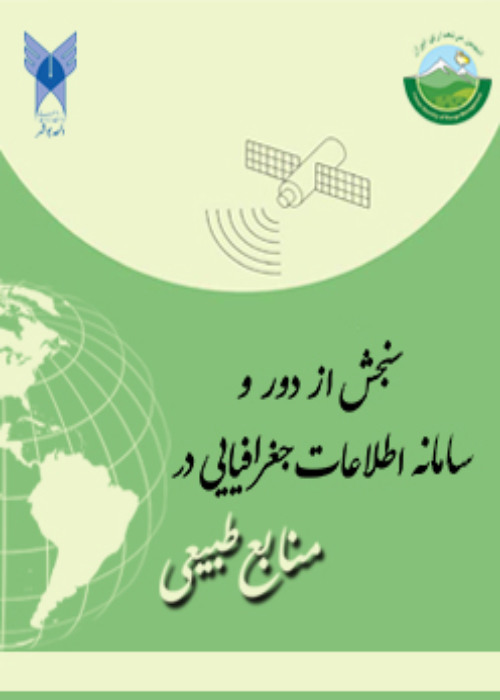Study the landuse change and its effects on the hydrologic regime in main catchments of Binalood county
Background and Objective Land use/cover changes have been considered to be one of the most important parts of global environmental changes. These changes are complex and dynamic in relation to other environmental changes (global warming, drought, erosion, and ecosystem degradation). In this context, the impacts of land use/cover changes on hydrologic processes are one of the most important environmental issues and challenges, so the extent of dependency on agriculture and other water-related activities on streams has become a major concern in watershed management. So, Assessing long-term hydrological impacts of land use/land cover (LULC) change is of critical importance for land use planning and water resource management. For example, Increased runoff due to the conversion of forests to other land covers, especially agriculture, as well as increased runoff and flood discharge resulting from the expansion of urban and residential use has been repeatedly reported by various researchers. The present study was aimed at identifying and determining the quantity and quality of land use changes and their relationship with flow discharge changes in catchments of Binalud county in order to guide water resources management and conservation of natural resources at the catchment scale, considering the evidence of land use changes as well as the hydrological regime variations in the catchments. Materials and Methods The data used in this study were as follows: the average monthly discharge of hydrometric stations, including 3 stations of ZirbandGolestan, Hesar, and SarasyabShandiz that were collected during 1990, 2000, 2010, and 2018, and the Landsat satellite images, including 4 satellite images for the years 1990, 2000, 2010 and 2020, acquired in the spring (May). The monthly discharge values of two seasons, winter and spring, were selected to study hydrological regime changes, considering the low and close to zero values of the average monthly discharge during summer and autumn and very small variance in the relevant values. The data were tested for normality at the significance level of 0.05 before entering the correlation test based on the Smirnov-Kolmograph method. In regard to satellite images, the processing steps were as follows: firstly, the atmospheric correction of the images was performed based on the conventional FLAASH method in the ENVI software environment. Then, the combination of visible green, red, and near-infrared bands in false color (4-3-2 in Landsat 5 and 7; 5-4-3 in Landsat 8) was used for classification based on the maximum likelihood algorithm. The land use classes were as follows: 1-garden, 2-residential, 3-water area, 4-rock outcrop, 5-moderate range, 6-poor range, and 7-barren land. The selection of training samples for classification was based on Google Earth images, visual interpretation of satellite images, and of course familiarity with the study area. After classification, the maps were validated based on general accuracy statistics and the Kappa coefficient. However, in order to know the relationship between land use changes and the hydrological regime of the catchments, Pearson two-way correlation test was used in the SPSS software environment. This test was performed at a significance level of 0.05 and between the percentages of the area of each land use and the monthly discharge values (6 months) of hydrometric stations during 4 year. Results and Discussion Preliminary results showed good accuracy of the classification method of the images so that kappa coefficients ranged from 0.78 to 0.95. According to the maps, it is characterized that most area of the catchments belongs to rangelands and barren lands so the changes and conversions of land use occurred mainly between these two land uses. The minimum area percentage of the catchments belonged to the water areas, which at its highest proportion occupied 0.16% and 0.1% of the area of ZirbandGolestan and SarasyabShandiz catchments, respectively. Reagards to land use changes, a decrease in rangelands and the increase of barren lands during the first (1990-2000) and the third (2010-2020) decades have been very considerable, so that 38% and 13% of the moderate rangelands of the Zirband catchment have decreased during the two decades, respectively. In contrast, barren lands have grown by 31% and 15 % over the two decades. Along with these changes, the 8% increase in the area of settlements has been proposed as the most prominent land use change during the second decade (2000-2010) in the catchments. In addition to land use changes, a review of the monthly discharge variations in the catchments showed that the winter months have been experiencing a decreasing trend and, in contrast, the spring months have been experiencing an increasing trend of discharge over the last two decades. The results of the correlation test showed that there are significant relationships between changes in areas of rock outcrop, moderate range, poor range, and discharge variations in the Zirband catchment. In contrast, no significant relationships were found between land uses and monthly discharges in the Sarasyab catchment. In regard to the quality of relationships, positive correlation between the areas of 3 land uses, including residential, rock outcrop, and barren land, and discharges in April and May, and in contrast, a negative correlation between rangeland areas and discharge of the mentioned months was another important result of the study. In general, the increase in human encroachment and occupation in the form of residential and barren land uses has increased the risks of the occurrence of flooding runoff. On the contrary, the rangeland expansion with its protective and moderating effect has reduced the occurrence of spring floods in the studied catchments. Conclusion The results indicate that an important focus of land use change in the catchments has been on rangeland and barren land, so in the last decades, the area of rangelands, which play an effective role in protecting water and soil resources, has been much larger than today. However, due to the lack of protection of pastures and human encroachment on the environment, as well as overgrazing of livestock, the rangelands have gradually retreated to the upstream areas and were replaced by barren lands and residential areas. The existence of a positive correlation between the areas of the residential, rock outcrop, and barren land and discharges in April and May is indicative of acceleration and intensification of the rainfall-runoff process due to the increase in the areas of the land uses. Therefore, the irregular and sprawling growth and expansion of residential areas, as well as barren and abandoned lands, must be prevented. On the other hand, the negative correlation between the percentage area of rangeland and monthly discharge refers to the positive effect of rangelands on the environmental conditions of the catchments in the context of accelerated runoff and erosion processes, which ultimately requires the protection and preservation of natural areas. In general, more attention and focus on the effects of land use change on discharge variations in wet seasons due to the semi-arid climate of the region is necessary.
- حق عضویت دریافتی صرف حمایت از نشریات عضو و نگهداری، تکمیل و توسعه مگیران میشود.
- پرداخت حق اشتراک و دانلود مقالات اجازه بازنشر آن در سایر رسانههای چاپی و دیجیتال را به کاربر نمیدهد.



